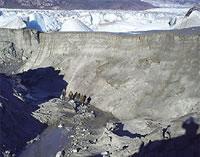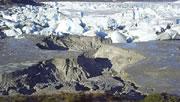 This giant hole held a lake just months ago.© CONAF, Chile's National Forest Service
This giant hole held a lake just months ago.© CONAF, Chile's National Forest ServiceA glacial lake in the Andes has disappeared mysteriously, prompting local geologists to head to Bernardo O'Higgins National Park in Patagonia, Chile, to find out what happened.
The lake, some 20,000 square metres in area, was last seen in March. By May, all that was left was a 30-metre-deep crater and a few pieces of stranded ice that used to float on top of the water. A river running from it had reduced to a trickle, according to the park rangers who first noticed the lake was missing.
It's not the first time that a lake has disappeared, although it is quite rare for bodies of water to vanish so quickly. In central Russia in May 2005, Lake Beloye disappeared "overnight" according to local reports. People assumed that the water had been sucked into an underground cave or river. Scott Lake, in Florida, disappeared into a sinkhole over the course of a week in June 2006.
Other lakes are known to be intermittent — existing for a season and then disappearing as water sources dry up, only to re-appear later.
Shaken and melted
 Many glacial lakes are dammed in by ice - which can melt.© CONAF, Chile's National Forest Service
Many glacial lakes are dammed in by ice - which can melt.© CONAF, Chile's National Forest ServiceOne explanation for the disappearing Chilean lake is an earthquake that happened in the neighbouring Aysén region in April, which measured 6.2 on the Richter scale. Such an earthquake might open up a crack in the earth or underlying ice, allowing the water to drain away.
But Stephan Harrison an expert on Patagonian glaciers at Exeter University, Penryn, Cornwall, suspects that melting ice is to blame. "This is probably just a natural process," he says.
Harrison points out that many glacial lakes are dammed by blocks of ice. "The ice will eventually melt," says Harrison — and that can release a torrent of water called a glacial lake outburst flood (GLOF). Such events are becoming more common, he says, as climate change causes more melting. But the speed at which this Chilean lake drained is unusual, he adds. GLOFs can also be triggered by earthquakes.
ADVERTISEMENT
Geologists are now rushing to the site to find out what happened. It is winter in Patagonia, and the site is very remote, so the trip could take up to two weeks. But once there the clues should be easy to spot. If the cause was an earthquake, they will find evidence of it pretty quickly, says John Chilton a hydrogeologist at the British Geological Survey, Wallingford. Seismic records, along with evidence of rock-fall could shore up this theory.
Equally, if a GLOF is to blame, there will be tell-tale signs of an ice dam being breached, says Harrison.
The water probably either drained away through the now-empty river, and into the sea, or it could have found its way into another water system nearby, perhaps underground.
Visit our lakeconfuses_geo.html">newsblog to read and post comments about this story.
